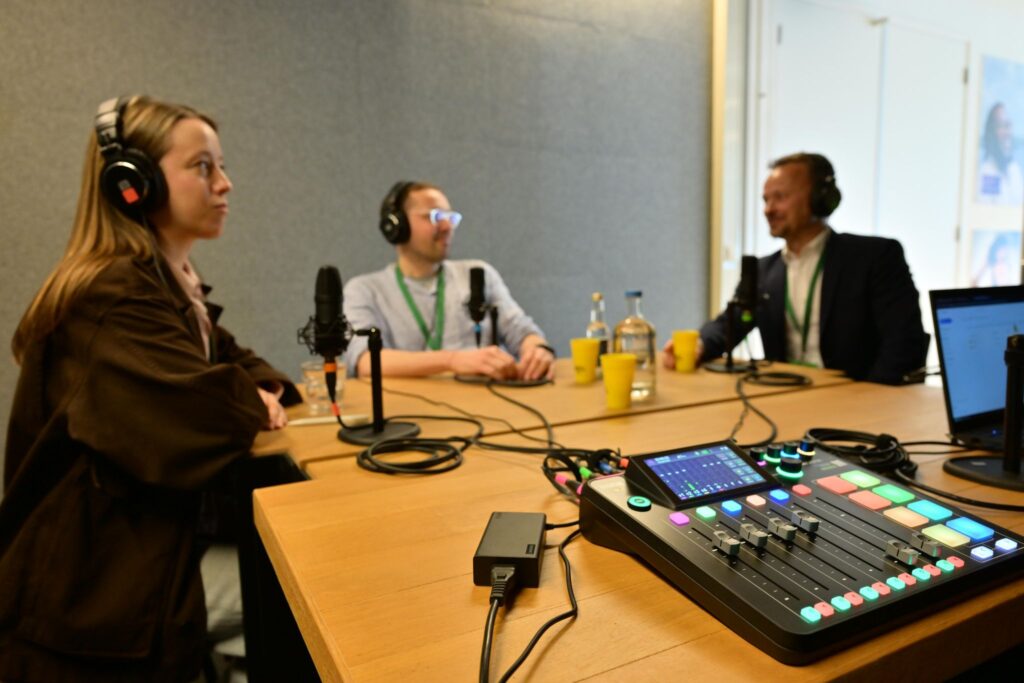Podcast series ‘User Needs First Across Borders’
During the User Needs First International Conference 2025 in Amsterdam, we sat down with leading experts and colleagues from international governments to explore how governments can truly put user needs first. This resulted in the making of 4 podcast episodes packed with honest, practical, and sometimes provocative conversations about human-centered design in policy, digital services, and cross-border collaboration.
Each episode offers unique insights, from designing for crises to embedding design in policymaking and learning across borders. Below you’ll find a short introduction to each one, plus links to listen on our website or your favorite podcast app.

Episode 1: Learning from others
How can governments truly put user needs first?
In this episode, Randy Semeleer talks with Morten Meyerhoff Nielsen (principal research specialist at the United Nations University-EGOV), Kara Kane (head of design at the Cabinet Office, UK Government), and Martin Jordan (head of design & user research at DigitalService, German Government). They discuss practical lessons on putting users before bureaucracy, learning across borders, and supporting strong design leadership. Highlights include:
- The importance of designing services around real-life user contexts
- Sharing methods and experiences internationally to strengthen approaches
- Building and sustaining communities to share knowledge, avoid repeating failures, and support continuous improvement
- Doing real research and co-design before national rollouts
They also share examples from the UK, Germany, France, Scotland, the Nordics, Faroe Islands, Ukraine, and Dubai. And they discuss why governments should document and share both successes and failures.
Episode 2: Design in policy
How do you make policymaking human-centered from the very start?
In this episode, recorded at the User Needs First International Conference, Randy talks with Anouschka Scholten (policity designer at the Dutch Ministry of the Interior and Kingdom Relations), Ottla Arrigoni and Yaprak Hamarat (policy analists at EU Policy Lab, European Commission).
They explore what it really takes to embed human-centered design in policymaking processes -beyond polished reports or top-down committees. It means inviting real users into the process early, working openly, and embracing iteration and prototypes, even when it’s uncomfortable.
They also discuss the cultural shift this demands within governments: sharing work in progress, balancing risk with experimentation, and even ‘hacking’ existing processes to make space for design methods. Their work at national and EU levels shows that while challenging, it’s possible – and essential – to put users and citizens at the heart of policy.
Episode 3: Human-centered design in digital transformation
How do you design truly human-centered digital government services—even in times of crisis?
Randy Semeleer talks with Richard Pope (co-founder of the UK Government Digital Service and author of Platformland) and Oleg Polovynko (advisor to the mayor of Kyiv, Ukraine).
It’s a candid and thought-provoking conversation about the real meaning of human-centered design in government. Oleg shares how Kyiv kept digital services running under wartime conditions, using extreme pressure to accelerate the development of user-friendly, inclusive, and reliable systems like the DIA platform – which lets citizens carry essential documents in a single app.
Richard reflects on lessons from the UK’s COVID-19 response, underlining that digital capacity isn’t just ‘nice to have’ but essential for resilience in crises from war to climate change. He also cautions about the risks of centralization and the need to think carefully about governance and trust.
Episode 4: Inclusion
This episode features:
- Marianne van den Anker, ombudsman Rotterdam-Rijmond region.
- Alexander Smit, researcher / lecturer University of Groningen.
- Priyanka D’Souza, senior user researcher, department for business and trade, UK government.
The focus of this episode is: About Inclusion, a real point of view from real people.
We hope these conversations inspire you to rethink how design and policy can better serve real people, especially in a complex and unpredictable world.
